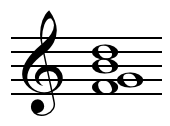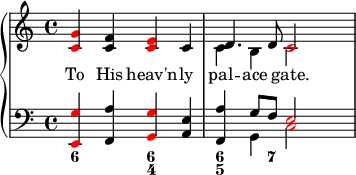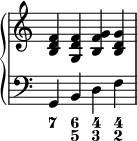
Figured bass is musical notation in which numerals and symbols appear above or below a bass note. The numerals and symbols indicate intervals, chords, and non-chord tones that a musician playing piano, harpsichord, organ, or lute should play in relation to the bass note. Figured bass is closely associated with basso continuo: a historically improvised accompaniment used in almost all genres of music in the Baroque period of Classical music, though rarely in modern music. Figured bass is also known as thoroughbass.

In music, harmony is the concept of combining different sounds together in order to create new, distinct musical ideas. Theories of harmony seek to describe or explain the effects created by distinct pitches or tones coinciding with one another; harmonic objects such as chords, textures and tonalities are identified, defined, and categorized in the development of these theories. Harmony is broadly understood to involve both a "vertical" dimension (frequency-space) and a "horizontal" dimension (time-space), and often overlaps with related musical concepts such as melody, timbre, and form.
In music theory, an interval is a difference in pitch between two sounds. An interval may be described as horizontal, linear, or melodic if it refers to successively sounding tones, such as two adjacent pitches in a melody, and vertical or harmonic if it pertains to simultaneously sounding tones, such as in a chord.
A seventh chord is a chord consisting of a triad plus a note forming an interval of a seventh above the chord's root. When not otherwise specified, a "seventh chord" usually means a dominant seventh chord: a major triad together with a minor seventh. However, a variety of sevenths may be added to a variety of triads, resulting in many different types of seventh chords.

A chord, in music, is any harmonic set of pitches consisting of multiple notes that are sounded simultaneously, or nearly so. For many practical and theoretical purposes, arpeggios and other types of broken chords may also be considered as chords in the right musical context.

In music theory, a major chord is a chord that has a root, a major third, and a perfect fifth. When a chord comprises only these three notes, it is called a major triad. For example, the major triad built on C, called a C major triad, has pitches C–E–G:

In Western music and music theory, diminution has four distinct meanings. Diminution may be a form of embellishment in which a long note is divided into a series of shorter, usually melodic, values. Diminution may also be the compositional device where a melody, theme or motif is presented in shorter note-values than were previously used. Diminution is also the term for the proportional shortening of the value of individual note-shapes in mensural notation, either by coloration or by a sign of proportion. A minor or perfect interval that is narrowed by a chromatic semitone is a diminished interval, and the process may be referred to as diminution.

In the music theory of harmony, the root is a specific note that names and typifies a given chord. Chords are often spoken about in terms of their root, their quality, and their extensions. When a chord is named without reference to quality, it is assumed to be major—for example, a "C chord" refers to a C major triad, containing the notes C, E, and G. In a given harmonic context, the root of a chord need not be in the bass position, as chords may be inverted while retaining the same name, and therefore the same root.
In music theory, an augmented sixth chord contains the interval of an augmented sixth, usually above its bass tone. This chord has its origins in the Renaissance, was further developed in the Baroque, and became a distinctive part of the musical style of the Classical and Romantic periods.
The term sixth chord refers to two different kinds of chord, the first in classical music and the second in modern popular music.

In music or music theory, a thirteenth is the note thirteen scale degrees from the root of a chord and also the interval between the root and the thirteenth. The thirteenth is most commonly major or minor.
In music theory, a ninth chord is a chord that encompasses the interval of a ninth when arranged in close position with the root in the bass.
The ninth chord and its inversions exist today, or at least they can exist. The pupil will easily find examples in the literature [such as Schoenberg's Verklärte Nacht and Strauss's opera Salome]. It is not necessary to set up special laws for its treatment. If one wants to be careful, one will be able to use the laws that pertain to the seventh chords: that is, dissonances resolve by step downward, the root leaps a fourth upward.

In music, a guitar chord is a set of notes played on a guitar. A chord's notes are often played simultaneously, but they can be played sequentially in an arpeggio. The implementation of guitar chords depends on the guitar tuning. Most guitars used in popular music have six strings with the "standard" tuning of the Spanish classical guitar, namely E–A–D–G–B–E' ; in standard tuning, the intervals present among adjacent strings are perfect fourths except for the major third (G,B). Standard tuning requires four chord-shapes for the major triads.
Jazz chords are chords, chord voicings and chord symbols that jazz musicians commonly use in composition, improvisation, and harmony. In jazz chords and theory, most triads that appear in lead sheets or fake books can have sevenths added to them, using the performer's discretion and ear. For example, if a tune is in the key of C, if there is a G chord, the chord-playing performer usually voices this chord as G7. While the notes of a G7 chord are G–B–D–F, jazz often omits the fifth of the chord—and even the root if playing in a group. However, not all jazz pianists leave out the root when they play voicings: Bud Powell, one of the best-known of the bebop pianists, and Horace Silver, whose quintet included many of jazz's biggest names from the 1950s to the 1970s, included the root note in their voicings.

The first inversion of a chord is the voicing of a triad, seventh chord, or ninth chord in which the third of the chord is the bass note and the root a sixth above it. In the first inversion of a C-major triad, the bass is E — the third of the triad — with the fifth and the root stacked above it, forming the intervals of a minor third and a minor sixth above the inverted bass of E, respectively.
Post-tonal music theory is the set of theories put forward to describe music written outside of, or 'after', the tonal system of the common practice period. It revolves around the idea of 'emancipating dissonance', that is, freeing the structure of music from the familiar harmonic patterns that are derived from natural overtones. As music becomes more complex, dissonance becomes indistinguishable from consonance.

In music, the seventh factor of a chord is the note or pitch seven scale degrees above the root or tonal center. When the seventh is the bass note, or lowest note, of the expressed chord, the chord is in third inversion.

Five-limit tuning, 5-limit tuning, or 5-prime-limit tuning (not to be confused with 5-odd-limit tuning), is any system for tuning a musical instrument that obtains the frequency of each note by multiplying the frequency of a given reference note (the base note) by products of integer powers of 2, 3, or 5 (prime numbers limited to 5 or lower), such as 2−3·31·51 = 15/8.
Musicians use various kinds of chord names and symbols in different contexts to represent musical chords. In most genres of popular music, including jazz, pop, and rock, a chord name and its corresponding symbol typically indicate one or more of the following:
- the root note,
- the chord quality,
- whether the chord is a triad, seventh chord, or an extended chord,
- any altered notes,
- any added tones, and
- the bass note if it is not the root.

Among alternative tunings for guitar, a major-thirds tuning is a regular tuning in which each interval between successive open strings is a major third. Other names for major-thirds tuning include major-third tuning, M3 tuning, all-thirds tuning, and augmented tuning. By definition, a major-third interval separates two notes that differ by exactly four semitones.







































